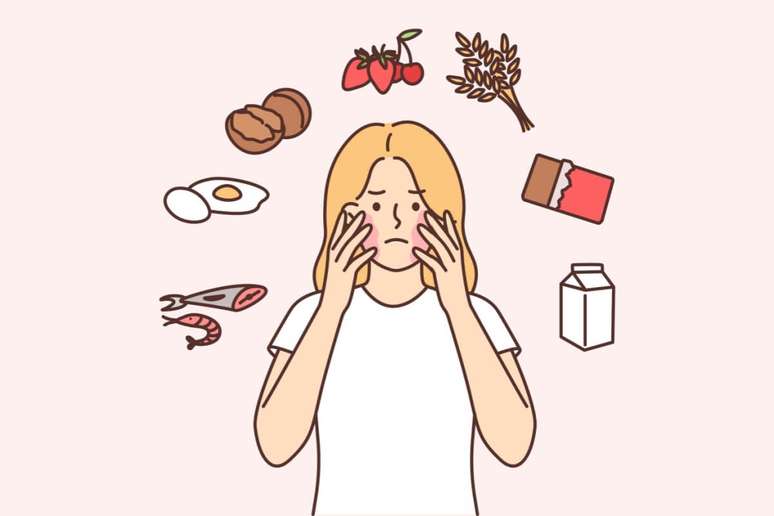Learn about the symptoms and treatments of this condition, which can range from mild to severe
Food allergy is an immune system response when the body identifies proteins in a food or drink as harmful to the body and, therefore, activates an exaggerated immune response, which can range from mild to severe and involve multiple body systems.
“A food allergy it can be a difficult condition. It is important that people with food allergies, as well as family members and healthcare professionals, are well informed and prepared to deal with possible allergic reactions”, warns nutritionist Dr. Marcella Garcez, master in Health Sciences from the PUCPR School of Medicine and director of the Brazilian Association of Nutrology.
Food allergy symptoms
Food allergy symptoms can vary from person to person, depending on the food consumed and the severity of the allergic reaction. “They usually appear within a few minutes to a few hours after ingesting the allergenic food,” explains Dr. Marcella Garcez.
According to the doctor, the most common symptoms are:
- Skin: hives (red patches), pruritus (itching) anywhere on the body, eczema (rash or dry skin), and angioedema (swelling of the deeper layers of the skin).
- Gastrointestinal: abdominal pain, nausea and vomiting, diarrhea and oral pruritus (itchy mouth).
- Respiratory: nasal congestion, rhinorrhea (excessive secretion of nasal mucus), sneezing, cough, wheezing, difficulty breathing and glottis edema (swelling in the throat which can make breathing difficult).
- Cardiovascular: dizziness, fainting, drop in blood pressure and palpitations.
In food allergies there is also the risk of anaphylaxis, which is a serious allergic reaction that can lead to death if not controlled quickly. The symptoms are:
- Throat swelling and difficulty breathing;
- Sharp drop in blood pressure;
- Loss of consciousness;
- Pulse rapid and weak;
- Generalized skin rashes and itching;
- Confusion and anxiety.
Food allergy or intolerance
Although they have some similar symptoms and even the same foods cause reactions, allergies and food intolerance they are different conditions. First, the body perceives food as an aggressor and, therefore, the immune system overreacts. The second occurs due to poor digestion of some foods, caused by the lack or absence of enzymes that transform larger molecules into smaller molecules, and does not involve a risk of death.
Foods that cause the most allergies
Any food can trigger an allergic reaction. “Food allergies are caused by proteins present in foods, which the immune system identifies as harmful,” reinforces Dr. Marcella Garcez. However, there are the most common ones that, according to the doctor, are called the “big eight” allergens.
Below he lists what they are:
- Milk: THE milk allergy it is common, especially among young children, and is usually caused by cow’s milk proteins
- Egg: The proteins found in egg whites are the ones most likely to cause allergies, although egg yolks can also be responsible.
- Peanuts: one of the most serious and potentially fatal food allergies.
- Oilseeds: Foods such as cashews, walnuts, almonds and hazelnuts generate similar reactions to peanuts and can be serious.
- Fish: Species such as salmon, tuna and cod can cause reactions that can persist into adulthood.
- Seafood: Reactions to shellfish and crustaceans, such as shrimp, crabs, and lobsters, can also be serious.
- Soy: Particularly common in children, this type of allergy can be overcome during childhood, but in some cases it persists.
- Grain: Reactions may occur due to the various proteins found in wheat, including gluten.
“In addition to these, other foods can also cause allergies, such as sesame seeds, mustard, corn, fruits and vegetables,” warns the nutritionist.

Diagnosis of food allergy
It is essential to consult a doctor who specializes in allergies and immunology when you identify symptoms or suspect a food allergy. For the diagnosis, in addition to the clinical evaluation, as Dr. Marcella Garcez explains, the doctor may request:
- Skin test: small amounts of food are applied to the skin;
- Blood analysis;
- Oral provocation test: the consumption of food suspicion is carried out in increasing doses under strict medical supervision;
- Elimination diet: completely avoid suspect foods for a set period of time.
- Peer-to-peer testing: quantities of food are applied to the skin and covered with a plaster for 48 hours;
- Food allergen component testing: tests for specific components of food proteins that can cause allergic reactions.
“Oral challenge, or offering the patient the food suspected of causing an allergy, is one of these tests, but it must be performed in a prepared environment in case anaphylaxis, a serious allergic reaction, occurs. Only qualified doctors can perform this type of test,” adds Dr. Lucila Camargo, coordinator of the Scientific Department of Food Allergy at the Brazilian Association of Allergy and Immunology (ASBAI).
Treatment of food allergies
To prevent food allergies it is essential not to consume the food that causes the allergic reaction. “It is important to avoid allergenic foods reading the label, ask about ingredients when eating out, and use safe products. Also be careful in the kitchen to avoid cross-contamination by using separate kitchen utensils,” recommends Dr. Marcella Garcez.
Additionally, food allergies can be treated with the use of antihistamines. In more severe cases, when anaphylactic shock and shortness of breath occur, an injection of adrenaline may be given. “Depending on the case, it is necessary to carry self-injectable adrenaline with you to control the crisis until you arrive at the emergency room,” explains Dr. Lucila Camargo.
There is also the possibility of allergy immunotherapy, which attempts to teach the immune system not to react to the food that causes the condition. All of these treatment options must be recommended and monitored by a doctor.
Source: Terra
Ben Stock is a lifestyle journalist and author at Gossipify. He writes about topics such as health, wellness, travel, food and home decor. He provides practical advice and inspiration to improve well-being, keeps readers up to date with latest lifestyle news and trends, known for his engaging writing style, in-depth analysis and unique perspectives.







